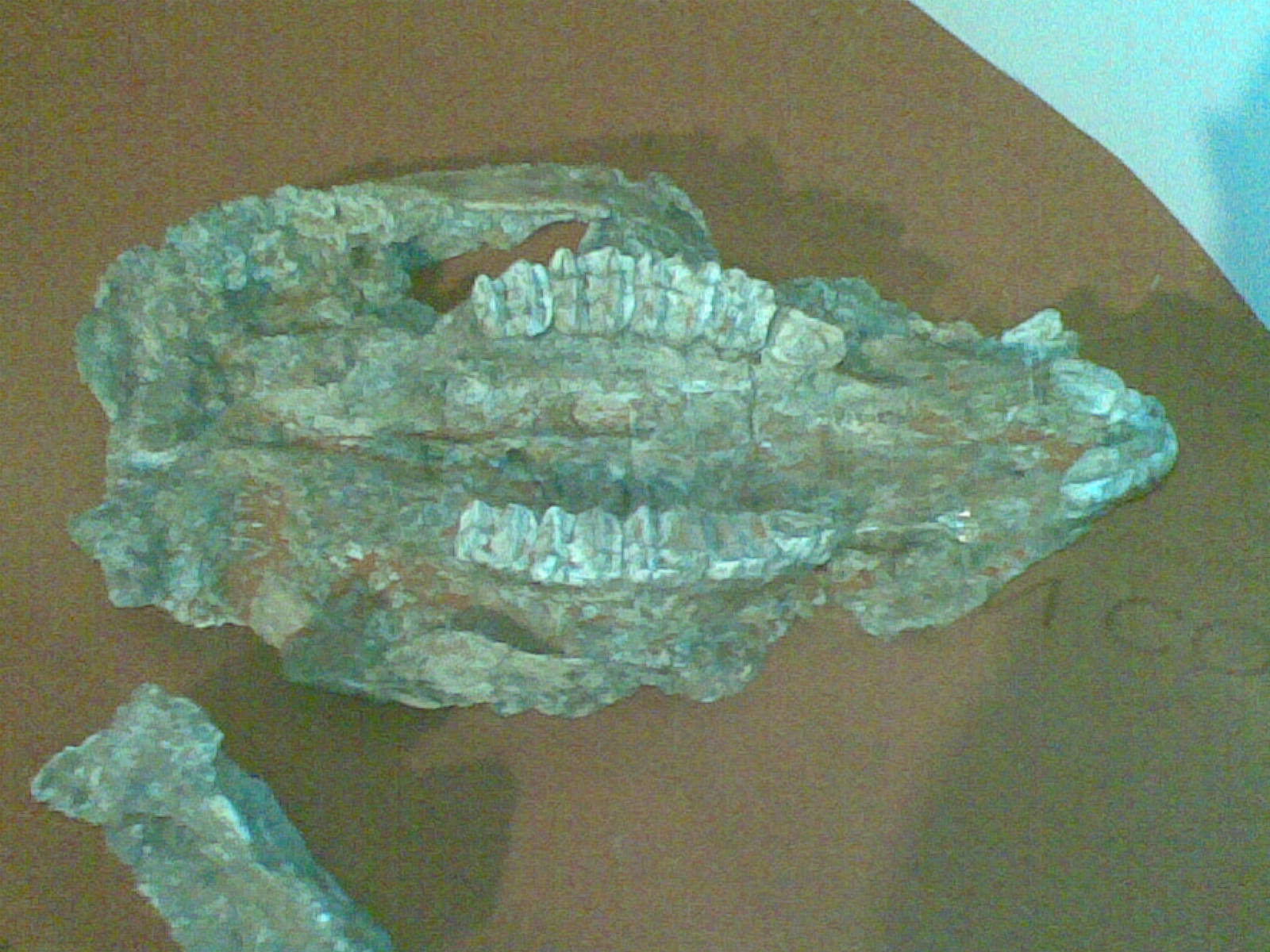- Sthenurus
Taxobox
name = "Sthenurus"cite web | author = Haaramo, M. | date =2004-12-20 | accessdate = 2007-03-15 | title = Mikko's Phylogeny Archive: Macropodidae - kenguroos | url = http://www.fmnh.helsinki.fi/users/haaramo/Metazoa/Deuterostoma/Chordata/Synapsida/Metatheria/Notometatheria/Diprotodontia/Macropodidae.htm] [cite journal | author = Gavin J. Prideaux, John A. Long, Linda K. Ayliffe, John C. Hellstrom, Brad Pillans, Walter E. Boles, Mark N. Hutchinson, Richard G. Roberts, Matthew L. Cupper, Lee J. Arnold, Paul D. Devine & Natalie M. Warburton | title = An arid-adapted middle Pleistocene vertebrate fauna from south-central Australia | journal =Nature | volume = 445 | pages = 422–425 | date =2007-01-25 | doi = 10.1038/nature05471 | url = http://www.nature.com/nature/journal/v445/n7126/fig_tab/nature05471_T1.html]
fossil_range = Pleistocene
regnum =Animal ia

image_width = 250px
image_caption = Palatel view of an Sthenurus sp skull.
phylum =Chordata
classis =Mammal ia
infraclassis =Marsupial a
ordo =Diprotodontia
familia =Macropodidae
subfamilia =Sthenurinae
genus = †"Sthenurus"
genus_authority = (Owen, 1873a)
subdivision_ranks =Paleospecies
subdivision = †"Sthenurus andersoni "
†"Sthenurus atlas "
†"Sthenurus browneorum "
†"Sthenurus gilli "
†"Sthenurus maddocki "
†"Sthenurus occidentalis "
†"Sthenurus oreas "
†"Sthenurus orientalis "
†"Sthenurus pales "
†"Sthenurus tindalei ""Sthenurus" ("Strong Tail") is an extinct genus of kangaroo. With a height of about 3 m (10 ft), some species were twice as large as modern extant species. "Sthenurus" was related to the better-known "
Procoptodon ".Fossil habitats
Research by Darren R. Gröcke from
Monash University , analysed the diets of fauna at various fossil site localites inSouth Australia , using stablecarbon isotope analysis 13C/12C ofcollagen . He found that at older localities likeCooper Creek the Sthenurus sp. was adapted to a diet of leaves and twigs (browsing). This was due to the wet climate of the time period between 132,000-108,000 years (TL anduranium dating), which allowed for a more varied vegetation cover.At the
Baldina Creek fossil site 30,000 years (C14 dating), the genus had adapted to a diet of grasses (grazing ). At this time the area was open grasslands with sparse tree cover as the continent was drier than today. But atDempsey's Lake ( 36-25,000 years) andRockey River (19,000 C14 dating), their diet was of both grazing and browsing. This analysis may be because of a wetter climatic period. The overall anatomy of the genus did not evolve for the change in diet and dentition did not adapt to the varying toughness of the vegetation between grasses, shrubs and trees. [Darren R. Gröcke (N/A) VIEPS Department of Earth Sciences, Monash University, Clayton, VIC 3168, Australia ST-grock@artemis.earth.monash.edu.au [http://www.the-conference.com/JConfAbs/1/221.html Carbon-Isotope Shifts Recorded in Megafaunal Dietary Niches of C3 and C4 Plants in the Late Pleistocene of South Australia: Correlation with Palaeofloral Reconstructions.] Monash University, Clayton. Retrieved on2007-06-26 .]Other species found in the Cuddie Springs habitat were the flightless bird
Genyornis , theRed kangaroo , theDiprotodon , humans and many others.cite web | url = http://www.smh.com.au/articles/2003/09/30/1064819934771.html | title = Maybe they didn't fit in the oven | accessdate = 2007-09-24 | last = Macey | first = Richard | year = 2003 | month = October | publisher = The Sydney Morning Herald] cite web | url = http://acl.arts.usyd.edu.au/research/cuddie/cuddie.html | title = Dinnertime at Cuddie Springs: hunting "and" butchering megafauna? | accessdate = 2007-09-24 | last = Furby | first = Judith | year = 1996 | month = December | publisher = University of Sydney]Anatomy
In anatomy they had a tail shorter but stronger than present species of Kangaroo, and only one toe instead (
monodactyl ) of three like theRed Kangaroo . At the end of the foot was a small hoof like nail suited for flat terrain;cite web | title = Extinct Animals- Simosthenurus occidentalis |work = ParksWeb | date = 2006 | url = http://www.parks.sa.gov.au/naracoorte/wonambi/animals/extinct/005803 | accessdate = 2007-07-02] this toe is considered their fourth toe.cite web | year = 2007 | title = The age of the Megafauna | work = ABC online | url = http://www.abc.net.au/science/ozfossil/megafauna/fauna/fauna.htm | accessdate = 2007-07-02]Their skeletal structure was very robust with powerful hind limbs, broad pelvis, longer arms and
phalanges than modern species and a short neck. Their phalangel bones that make up their fingers may have been used to hold stems and twigs. These unique adaptations suited their feeding habits of browsing in the case of S. occidentalis, but other species were most likely grazers.They possessed a short deep skull which was suited for eyes with
stereoscopic vision ; this allowed for better vision.Teeth
These structures were tough and strongly
enamel ed, useful for tough vegetation and with a striation pattern.Human interaction
From evidence gathered at
Cuddie Springs according to Judith Field and Richard Fullagerit (as cited in Macey 2003) it is known thatNative Australians inhabited the same habitat as that of Sthenurus and various otherextant and extinct species of animal. At this locality there seems to be a lack of any specific tools suitable for hunting. Instead there are tools used to cut meat off the bone, as there is blood residue left on the stone tools. Any material made of wood for hunting like theboomerang andspear has either not survived intact or was not used by the people of the time in this locality.References
*Gavin Prideaux, "Systematics and Evolution of the Sthenurine Kangaroos" (April 1, 2004). UC Publications in Geological Sciences. Paper vol_146. http://repositories.cdlib.org/ucpress/ucpgs/vol_146
External links
* [http://www.museum.vic.gov.au/prehistoric/mammals/sthenurines.html Victoria museum.]
* [http://www.pbs.org/wgbh/nova/bonediggers/vani-04.html Australias Vanished Beasts, With a picture of Sthenurus.]
* [http://digitallibrary.amnh.org/dspace/bitstream/2246/1626/1/B225a01.pdf Sthenurus from the American Museum of Natural History.]
* [http://www.angellis.net/Web/DFG-mam/Sthenurus.htm Outlines of the various species.]
* [http://www.parks.sa.gov.au/naracoorte/wonambi/animals/extinct/005803 Naracoorte caves.]
Wikimedia Foundation. 2010.
